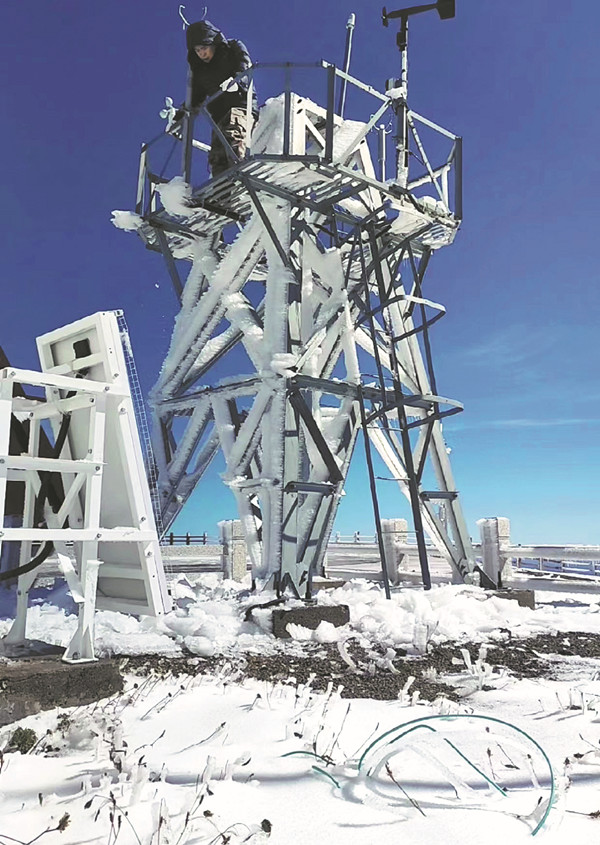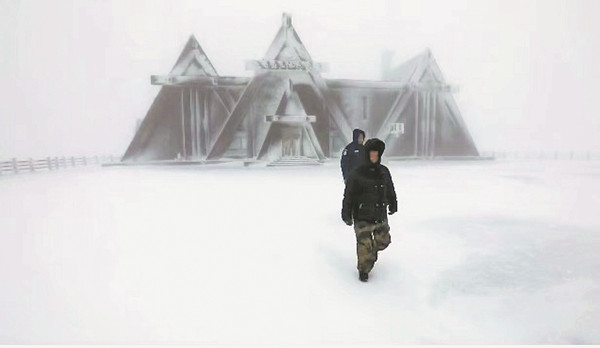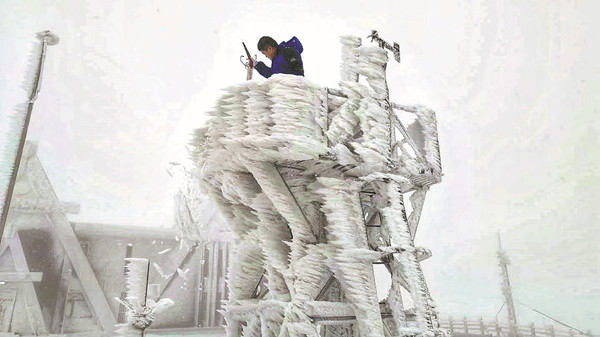
A meteorologist works on a tower at the Tianchi Meteorological Station in Antu county, Jilin province. [Photo provided to China Daily]
Meteorologists in Jilin province endure harsh conditions while working at mountain facility to provide valuable data
Since the Tianchi Meteorological Station was set up in 1958, generations of employees have done their part to produce accurate weather data from Changbai Mountain in Jilin province.
Tianchi is one of China's designated first-class weather stations, and was developed under tough conditions. Its 53-year-old director Jiao Xiangzhao has worked there for 24 years.
After graduating from senior high school in 1989, Jiao found work in a factory in Antu county in the Yanbian Korean autonomous prefecture.
In 1995, he decided to continue his studies and was admitted to the Nanjing University of Meteorology in Jiangsu province, which became the Nanjing University of Information Science and Technology in 2004.
After earning his bachelor's in 1998, he became a meteorological observer at the Songjiang township station in Antu. He shifted to the Tianchi station in June 1999.
"Before me, there were no permanent meteorologists here," he said.
"At certain times of the year, staff would be chosen from different departments of the prefecture's meteorological bureau to come up here to work."

Two meteorologists walk outside the station. [Photo provided to China Daily]
The Tianchi station lies at an altitude of 2,620 meters and is about 150 meters from Tianchi Lake on the top of Changbai Mountain. Workers enjoy spectacular views, but endure harsh weather conditions.
The average annual temperature is — 7.3 C with winds of up to 74 kilometers per hour registered 280 days a year.
In addition, there are 250 days of snow and 56 days of severe thunderstorms annually.
The station was founded in 1958 to improve weather data collection. These days, workers are also responsible for keeping track of the effects of climate change and in charge of wildlife protection in the Changbai Mountain region.
Meteorologists remain at the station from June to September and in other months, they carry out weekly inspections of equipment to keep everything in working order.
Jiao remembers that his first day of work was difficult. "The pickup truck we took had to stop when we were one-third of the way to the station due to heavy snowfall," he said.
He and four colleagues took four hours to reach the mountain top, each carrying a 20-kilogram bag filled with food and meteorological instruments. Every day for the next four months, Jiao made eight observations and sent data to the provincial meteorological bureau and the National Meteorological Center six times.
The mountain's meteorologists have developed methods for coping with the harsh weather.
"For example, when the wind is really strong, I tie a rope around my waist, and one of my colleagues holds the other end as I walk to the observation field," he said.
"After recording the data, I signal them to pull me back in."
Thunderstorms are also a cause of concern, as the observation tower is often struck by lightning, which can damage the transmitter even if the power is turned off.
In one incident in June 2016, the equipment was so badly damaged, there was a power failure, and the generator fuel almost ran out at the end.
To save on fuel, the meteorologists decided to forgo heating and instead used the remaining power to upload data.
"We had to sleep in an ice-cold room for the night," he said.
"However, the most important thing was to transmit the data accurately and on time."
In addition to such difficulties, they also have to deal with how to occupy their free time.
"We often felt quite bored after work," he said.
"Before 2006, there was no power supply, and we couldn't access the internet until 2018."
Over the past decade, conditions have improved significantly.

Snow covers buildings and towers at the station in the winter. [Photo provided to China Daily]
Since 2010, manual equipment has been gradually replaced by automated devices, and in 2012, an internal dedicated transmission network for meteorological data was established.
In 2016, a new 1,000-square-meter facility was built to house the station.
"They used triple-glazed glass to protect against strong winds. Special welding techniques were also used to make the facility sturdier," Jiao said.
"The working environment has greatly improved, and most of the observation tasks are automated for the safety of meteorologists."
Overall though, Jiao is very happy with his work.
"As an important national meteorological station, we undertake the duty not only of meteorological monitoring, but also of forecasting and early warning," he said.
"As a meteorologist, I feel proud of contributing to local traffic safety and people's lives."
Contact the writers at zhouhuiying@chinadaily.com.cn







